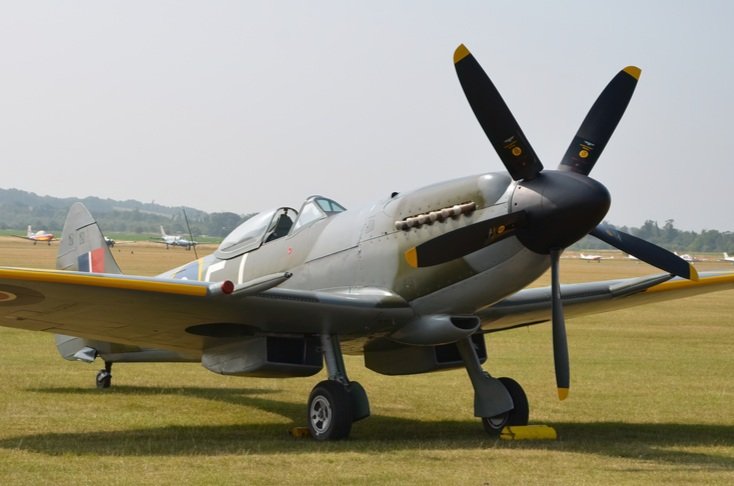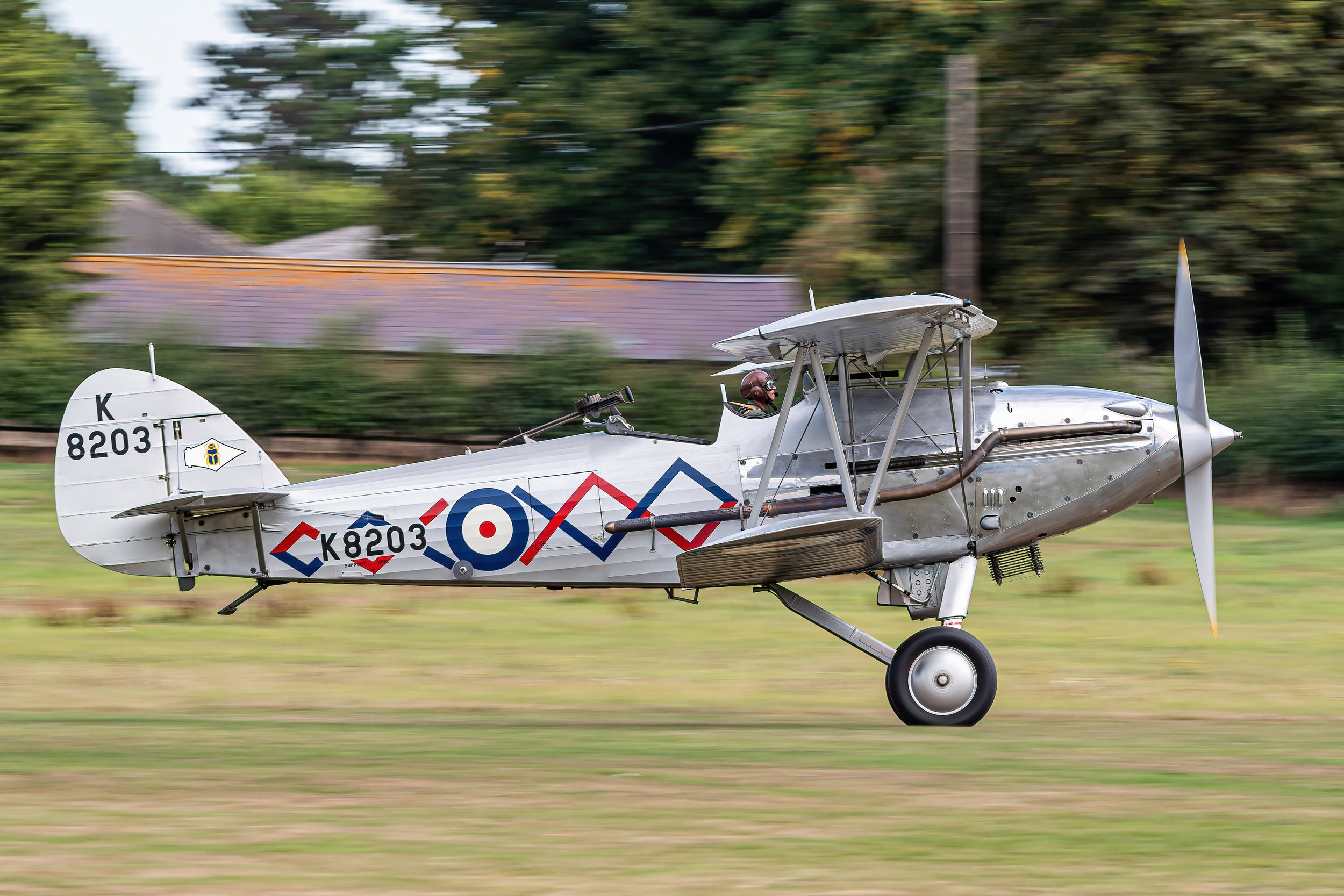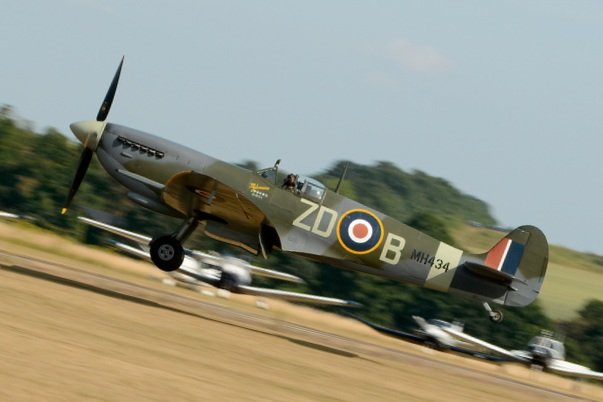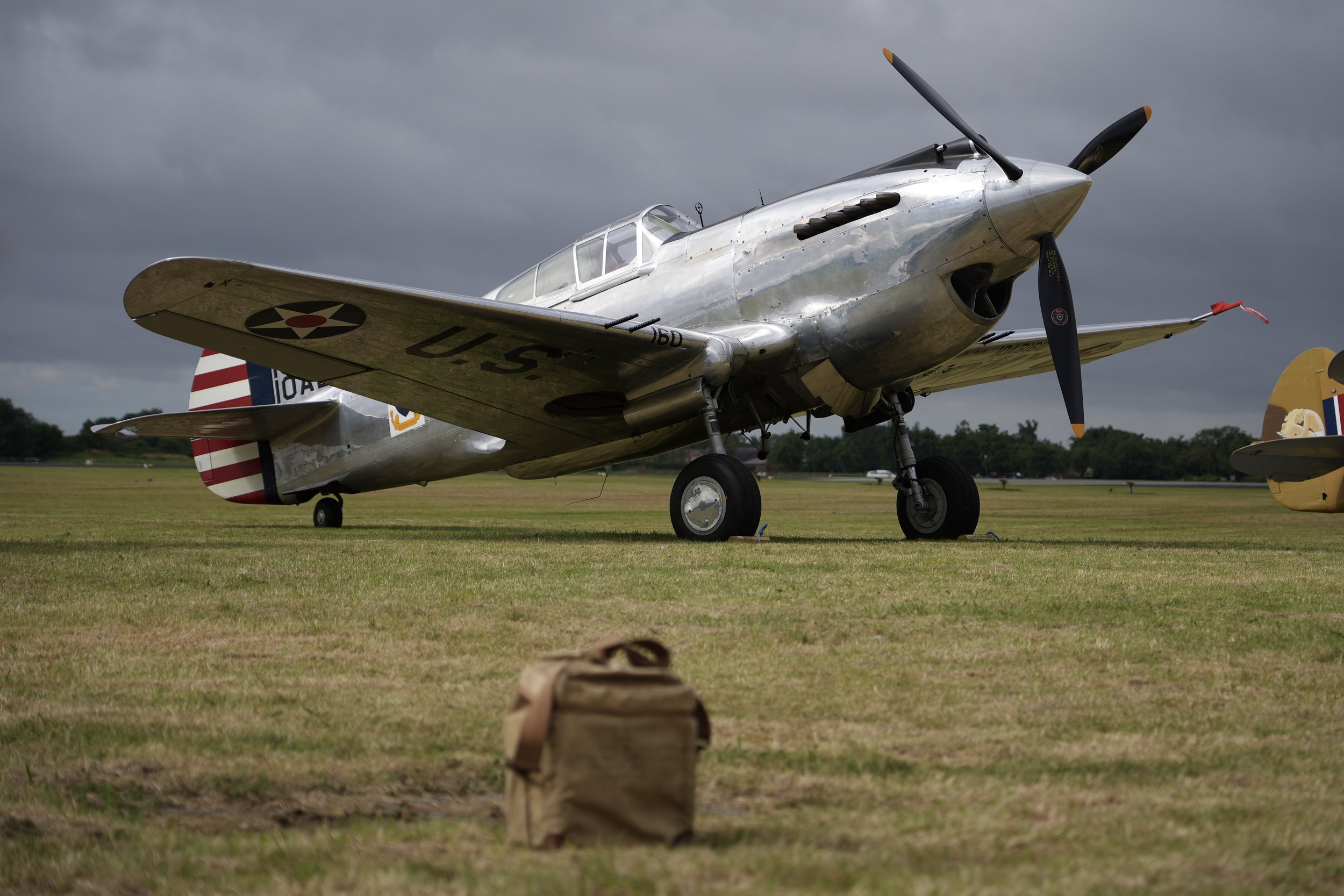Bearcat G-RUMM
Year built
1948
Aircraft
F8F-2P Bearcat
Base
Duxford Airfield
The Fighter Collection Bearcat was built in 1948 and taken on charge in August of that year by the US Navy. She served at a number of Naval Air Stations before undergoing modification to the F8F-2P standard in 1952. Following further Navy service, she was finally struck off charge in January 1957. She passed through two sets of private ownership in the US, the first between 1957 and 1972, and the second until 1981. It was under this second private ownership that she underwent a full overhaul and flew once again in 1975. It was in 1981 that the Bearcat joined what was to become The Fighter Collection and has gone on to be the longest-serving member of the fleet.
| Back to Top |
Grumman F8F-2P Bearcat
The Grumman F8F Bearcat is an American single-engine carrier-based fighter aircraft introduced in late World War II. It served during the mid-20th century in the United States Navy, the United States Marine Corps, and the air forces of other nations. It was Grumman Aircraft's last piston-engined fighter aircraft.
Modified versions of the Bearcat have broken speed records for piston-engined aircraft. Today, the Bearcat is popular among warbird owners and air racers.
The Bearcat concept began during a meeting between Battle of Midway veteran F4F Wildcat pilots and Grumman Vice President Jake Swirbul at Pearl Harbor on 23 June 1942. At the meeting, Lieutenant Commander Jimmie Thach emphasized one of the most important requirements in a good fighter plane was "climb rate".
Climb performance is strongly related to the power-to-weight ratio and is maximized by wrapping the smallest and lightest possible airframe around the most powerful available engine. Another goal was that the G-58 (Grumman's design designation for the aircraft) should be able to operate from escort carriers, which were then limited to the obsolescent F4F Wildcat as the Grumman F6F Hellcat was too large and heavy. A small, lightweight aircraft would make this possible. After intensively analyzing carrier warfare in the Pacific Theater of Operations for a year and a half, Grumman began the development of the G-58 Bearcat in late 1943.
In 1943, Grumman was in the process of introducing the F6F Hellcat, powered by the Pratt & Whitney R-2800 engine which provided 2,000 horsepower (1,500 kW). The R-2800 was the most powerful American engine available at that time, so it would be retained for the G-58. This meant that improved performance would have to come from a lighter airframe.
To meet this goal, the Bearcat's fuselage was about 5 feet (1.5 m) shorter than the Hellcat and was cut down vertically behind the cockpit area. This allowed the use of a bubble canopy, the first to be fitted to a US Navy fighter. The vertical stabilizer was the same height as the Hellcat's, but increased aspect ratio, giving it a thinner look. The wingspan was 7 feet (2.1 m) less than the Hellcats. Structurally the fuselage used flush riveting as well as spot welding, with a heavy gauge 302W aluminium alloy skin suitable for carrier landings. Armour protection was provided for the pilot, engine and oil cooler.
The Hellcat used a 13 ft 1 in (3.99 m) three-bladed Hamilton Standard propeller. A slight reduction in size was made by moving to a 12 ft 7 in (3.84 m) Aero products four-bladed propeller. Keeping the prop clear of the deck required long landing gear, which, combined with the shortened fuselage, gave the Bearcat a significant "nose-up" profile on land. The hydraulically operated undercarriage used an articulated trunnion which extended the length of the oleo legs when lowered; as the undercarriage retracted the legs were shortened, enabling them to fit into a wheel well which was entirely in the wing. An additional benefit of the inward retracting units was a wide track, which helped counter propeller torque on takeoff and gave the F8F good ground and carrier deck handling.
The design team had set the goal that the G-58 should weigh 8,750 pounds (3,970 kg) fully loaded. As development continued it became clear this was impossible to achieve as the structure of the new fighter had to be made strong enough for aircraft carrier landings. Ultimately much of the weight-saving measures included restricting the internal fuel capacity to 160 US gallons (610 l)(later 183 US gallons [690 l]) and limiting the fixed armament to four .50 cal Browning M2/AN machine guns, two in each wing. The limited range due to the reduced fuel load would mean it would be useful in the interception role but meant that the Hellcat would still be needed for longer range patrols. A later role was defending the fleet against airborne kamikaze attacks. Compared to the Hellcat, the Bearcat was 20% lighter, had a 30% better rate of climb and was 50 mph (80 km/h) faster.
Another weight-saving concept the designers came up with was detachable wingtips. The wings were designed to fold at a point about 2⁄3 out along the span, reducing the space taken up on the carrier. Normally the hinge system would have to be built very strong in order to transmit loads from the outer portions of the wing to the main spar in the inner section, which adds considerable weight. Instead of building the entire wing to be able to withstand high-g loads, only the inner portion of the wing was able to do this. The outer portions were more lightly constructed, and designed to snap off at the hinge line if the g-force exceeded 7.5 g. In this case, the aircraft would still be flyable and could be repaired after returning to the carrier. This saved 230 pounds (100 kg) of weight.
The design was completed in November 1943 and an order for two prototypes was placed on 27 November 1943 under the BuAir designation XF8F-1. The first prototype flew on 21 August 1944, only nine months after the design effort started. The initial flight test demonstrated a 4,800 feet (1,500 m) per minute climb rate and a top speed of 424 mph (682 km/h). Compared to the Vought F4U Corsair, the Bearcat was marginally slower but more manoeuvrable and climbed more quickly.
Testing demonstrated a number of problems, notably a lack of horizontal stability, an underpowered trim system, landing gear that could be extended only at slow speeds, an unreliable airspeed indicator, and a cramped cockpit. The test pilots also requested that six guns be installed. The stability problem was addressed on the second prototype by adding a triangular fillet to the front of the vertical stabilizer. The extra guns could not be incorporated due to weight and balance considerations.
The Navy placed a production contract for 2,023 aircraft based on the second prototype on 6 October 1944. On 5 February 1945, they awarded another contract for 1,876 slightly modified aircraft from General Motors, given the designation F3M-1. These differed primarily in having the R-2800-34W engine and a small increase in fuel capacity.
Deliveries from Grumman began on 21 May 1945. The end of the war led to the Grumman order being reduced to 770 examples, and the GM contract being cancelled outright. An additional order was placed for 126 F8F-1B's replacing the .50 cal machine guns with the 20 mm M2 cannon, the US version of the widely used Hispano-Suiza HS.404. Fifteen of these were later modified as F8F-1N night fighters with an APS-19 radar mounted under the starboard wing.
An unmodified production F8F-1 set a 1946 time-to-climb record (after a run of 115 ft [35 m]) of 10,000 feet (3,048 m) in 94 seconds (6,383 ft/min [32.43 m/s]). The Bearcat held this record for 10 years until it was broken by a jet fighter (which still could not match the Bearcat's short takeoff distance).
In 1948 Grumman introduced a number of improvements to produce the F8F-2. Among the changes were a modified cowling design, a taller vertical fin, and the slightly more powerful R-2800-30W engine producing 2,240 hp (1,670 kW). A total of 293 F8F-2s were produced, along with 12 F8F-2N night fighters and 60 F8F-2P reconnaissance versions.
Production ended in 1949, and the first units began to convert off the type that year. The last Bearcats were withdrawn in 1952.
| Back to Top |













| Back to Top |

































